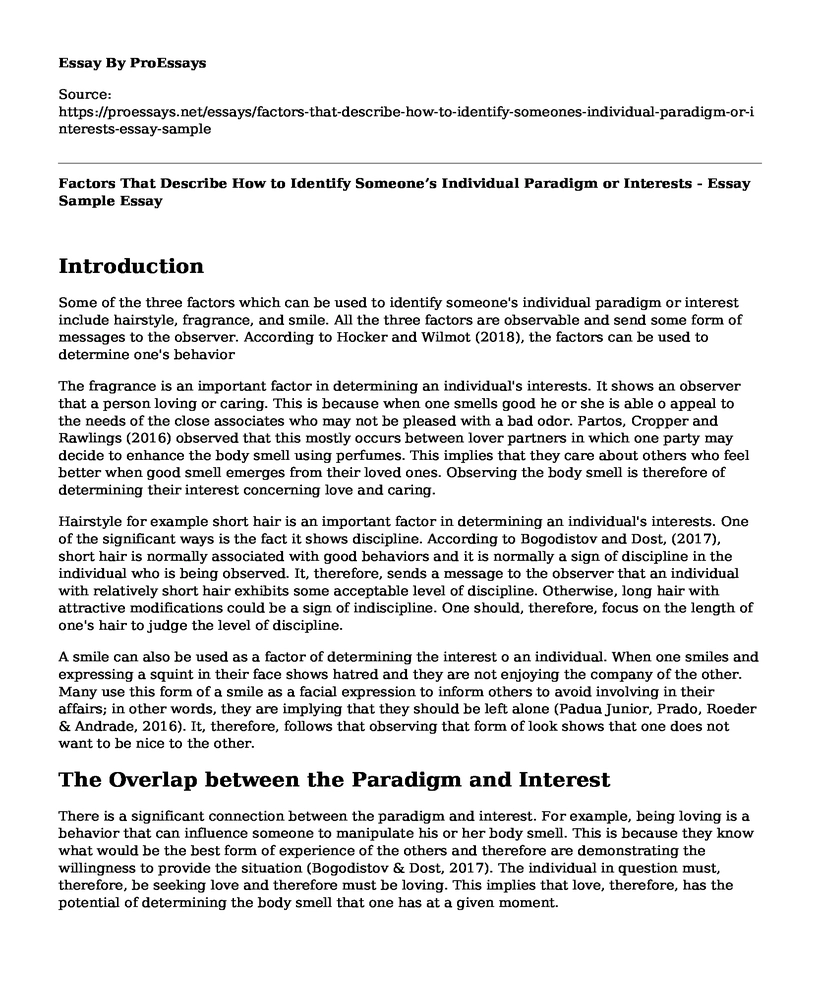Introduction
Some of the three factors which can be used to identify someone's individual paradigm or interest include hairstyle, fragrance, and smile. All the three factors are observable and send some form of messages to the observer. According to Hocker and Wilmot (2018), the factors can be used to determine one's behavior
The fragrance is an important factor in determining an individual's interests. It shows an observer that a person loving or caring. This is because when one smells good he or she is able o appeal to the needs of the close associates who may not be pleased with a bad odor. Partos, Cropper and Rawlings (2016) observed that this mostly occurs between lover partners in which one party may decide to enhance the body smell using perfumes. This implies that they care about others who feel better when good smell emerges from their loved ones. Observing the body smell is therefore of determining their interest concerning love and caring.
Hairstyle for example short hair is an important factor in determining an individual's interests. One of the significant ways is the fact it shows discipline. According to Bogodistov and Dost, (2017), short hair is normally associated with good behaviors and it is normally a sign of discipline in the individual who is being observed. It, therefore, sends a message to the observer that an individual with relatively short hair exhibits some acceptable level of discipline. Otherwise, long hair with attractive modifications could be a sign of indiscipline. One should, therefore, focus on the length of one's hair to judge the level of discipline.
A smile can also be used as a factor of determining the interest o an individual. When one smiles and expressing a squint in their face shows hatred and they are not enjoying the company of the other. Many use this form of a smile as a facial expression to inform others to avoid involving in their affairs; in other words, they are implying that they should be left alone (Padua Junior, Prado, Roeder & Andrade, 2016). It, therefore, follows that observing that form of look shows that one does not want to be nice to the other.
The Overlap between the Paradigm and Interest
There is a significant connection between the paradigm and interest. For example, being loving is a behavior that can influence someone to manipulate his or her body smell. This is because they know what would be the best form of experience of the others and therefore are demonstrating the willingness to provide the situation (Bogodistov & Dost, 2017). The individual in question must, therefore, be seeking love and therefore must be loving. This implies that love, therefore, has the potential of determining the body smell that one has at a given moment.
Besides, considerable overlap exists between smile and discipline. A disciplined individual could prefer short hair based on the requirements of a given context. Short hair implies that one's life is associated with limited complexities and strives to fit within some official requirements (Padua et al., 2016). As a result, being ethical in this manner may influence an individual to have short hair so that they can be observed and perceived as disciplined. There is, therefore, a great influence that discipline has on the hairstyle.
An unpleasant smile also has a relationship with a bad attitude. When one is antisocial, he or she may not present a pleasant smile. Hatred can manifest in an individual when they are not showing their whole. They could smile with a partially closed eye and the teeth are not seen. There is, therefore, a significant connection since seeing no value in a person makes one give such a poor smile.
References
Bogodistov, Y., & Dost, F. (2017). Proximity Begins with a Smile, But Which One? Associating Non-duchenne Smiles with Higher Psychological Distance. Frontiers In Psychology, 8. Doi: 10.3389/fpsyg.2017.01374
Hocker, J. L., & Wilmot, W. W. (2018). Interpersonal conflict (10th ed.). New York, NY: McGraw Hill
Padua Junior, F., Prado, P., Roeder, S., & Andrade, E. (2016). What a Smile Means: Contextual Beliefs and Facial Emotion Expressions in a Non-verbal Zero-Sum Game. Frontiers In Psychology, 7. Doi: 10.3389/fpsyg.2016.00534
Partos, T., Cropper, S., & Rawlings, D. (2016). You Don't See What I See: Individual Differences in the Perception of Meaning from Visual Stimuli. PLOS ONE, 11(3), e0150615. Doi: 10.1371/journal.pone.0150615
Bogodistov, Y., & Dost, F. (2017). Proximity Begins with a Smile, But Which One? Associating Non-duchenne Smiles with Higher Psychological Distance. Frontiers In Psychology, 8. Doi: 10.3389/fpsyg.2017.01374
Cite this page
Factors That Describe How to Identify Someone's Individual Paradigm or Interests - Essay Sample. (2022, Dec 19). Retrieved from https://proessays.net/essays/factors-that-describe-how-to-identify-someones-individual-paradigm-or-interests-essay-sample
If you are the original author of this essay and no longer wish to have it published on the ProEssays website, please click below to request its removal:
- Paper Example on Deviance and Social Control
- The Effects of Divorce on Children Paper Example
- Essay Sample on Revenge Leads to Pain: A Study of Fictional Characters
- Essay Example on 5 Models of Death and Dying: Kubler-Ross's Stages
- Personality: Nature vs Nurture: The Debate Over Development - Research Paper
- Essay Example on Mental Illness Across the World: The Hidden Picture Insight
- Essay Sample on Coping with Crisis: Navigating Emotional Disorder & Disruption







